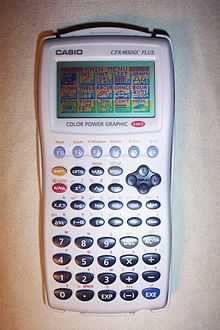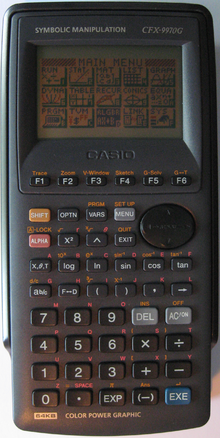Casio 9850 series
 Black model of the CFX-9850GB PLUS with protective slide cover, showing the menu-based interface on its screen. | |
| Type | Programmable Graphing |
|---|---|
| Manufacturer | Casio |
| Introduced | 1996 |
| Discontinued | 2008 |
| Calculator | |
| Entry mode | Infix |
| Display Type | LCD Dot-matrix |
| Display Size | 128×64 dots |
| Programming | |
| Programming language(s) | BASIC-like |
| User Memory | 32 kibibyte |
| Other | |
| Power supply | four AAA alkaline batteries |
| Weight | 190 gram |
The Casio CFX-9850G series is a series of graphing calculators manufactured by Casio Computer Co., Ltd. from 1996 to 2008.
Overview
The Casio CFX-9850G was introduced in 1996. As a higher-end version of the FX-9750G series, The CFX-9850G introduced a number of enhancements over that series, the most noticeable being a color LCD display capable of displaying orange, green, and blue. The CFX-9850G was later replaced with updated models that added features and fixed bugs, the CFX-9850G Plus, Ga Plus, GB Plus, and GC Plus. The CFX-9850GB Plus includes a built-in software library, and the CFX-9850GC Plus increases memory from 32k to 64k. Two other models were sold alongside the CFX-9850G series, the CFX-9950G series, which has 64k of memory, and the CFX-9970G, which has symbolic algebra. The series was discontinued with the CFX-9850GC Plus in 2008.
There are French versions where the ab/c and EXP buttons are labelled differently. (French versions: 9750=Graph 30,35,fx-8930GT; 9850,9950=Graph 60,65,CFX-9930GT,9940,9960; 9970=Graph 80)
The calculators weigh about 190 grams including batteries, and measure about 19.7 mm x 83 mm x 176 mm. Features include scientific calculations, including calculus, graphing and programming, statistics and matrix operations.
Power
The back of the device shows a slightly protruding battery case cover, which slides out to reveal the compartment for the four AAA alkaline batteries used for primary power, and a CR2032 lithium button cell used for memory backup when primary power is down or being changed. The device consumes power at the rate of 0.06W, and turns itself off automatically after about 6 minutes of time spent without any keypad activity. Battery life for the primary power cells ranges from 240 hours to 150 hours, depending on the kind of battery being used. Backup cells last up to about 2 years each.
Display


The display has a graphics resolution of 128 by 64 pixels (the first row and column of pixels are unusable in graphing), and a character resolution of 21 columns by 8 lines. The bottom line is reserved for function key menu tips, and the rest is available for the graphics and character display.
The display is capable of displaying three colors: orange, blue and green. The colors are handled much like a multi-level grayscale display, in that altering the contrast of a pixel changes its color. A light contrast displays orange, then as the contrast increases, the color becomes blue, then green at a dark contrast.
Memory
The calculators come with 32 or 64 kibibytes of inbuilt memory depending on the model. This is flexibly divided among storage blocks for programs, statistics, matrices, lists, static and dynamic graphs and their associated settings, functions, recursions, equations, financial data, and variables (all of which are global). These can be cleared individually or completely in the MEM menu.
Communications
The device can link up via specialized cables to a computer (FA-122 interface unit and cables) or to another calculator (SB-62 cable) to transfer data, such as programs, equations, graphs etc. It can also connect to a Casio label printer (SB-62 cable). Transmission speed is stated as 9600 byte/s.
The serial link cable was designed and U.S. patented (5504864) by Larry Berg of Purple Computing. It was manufactured by Traveling Software (AKA Laplink.com) and later by Purple Computing for Casio. The common name for the cable used by the companies was "PC-Link". It has a 2.5mm stereo phono plug on one end, the patented electronic circuit inside the plastic bump and a DE-9F on the other for connecting to the serial port of a PC. The circuit converts low voltage low power signals of the handheld device to be compatible with the levels and power of a PC's RS232 serial port. Versions of the circuit were used by many companies from the early 1990s to bridge the RS232/TTL voltage/power gap.
Software Library
The CFX-9850GB PLUS and CFX-9950GB PLUS models have a built-in software library, consisting of programs that perform complicated calculations and data processing. For example, operations on differential equations, digital caliper measurements, capacitor charge curves, figure rotations and Riemann sums. These are organized into six sub-libraries, five of them for mathematical computations, and one for scientific instrumentation.
Graphing
Graphs can be drawn with split-screen viewing of graphs as well as tables or zooms. Graphed areas can be shaded in customizable colors. The graph viewport can be resized and shifted (these settings can be saved for later retrieval), and points along the graph curves can be traced. Graph solver tools can also be used to find useful points, such as maxima/minima and intersection points. The calculator also has a special section for advanced conic section graphing. Dynamic graphing provides all the functionality of regular graphing, but allows the binding of a variable in the graph equation to time over a value range.
Lists and tables
Up to 36 lists can be stored and manipulated in various ways in the list manager. The lists can be also be used to feed data into inbuilt statistics operations, producing various statistical figures, performing regression analysis, and generating graphs like scatter and box and whisker plots, among others. Tables can be generated from functions, recursive series can be generated, and equations can be solved - both simultaneous and polynomial.
Financial calculations
A number of financial operations such as interest compounding and amortization are also provided.
Trivia
According to the BogoMips mini-Howto, the calculator scores at 0.000027 BogoMips. [1] It uses a Hitachi HCD62121 CPU custom-built for the Casio 9850 series.
References
- ↑ Dorst, Wim van. "Compilation of ratings".
Manuals
External links
| ||||||||||||||
| |||||||||||||||||||||||||||||||||||||||||
